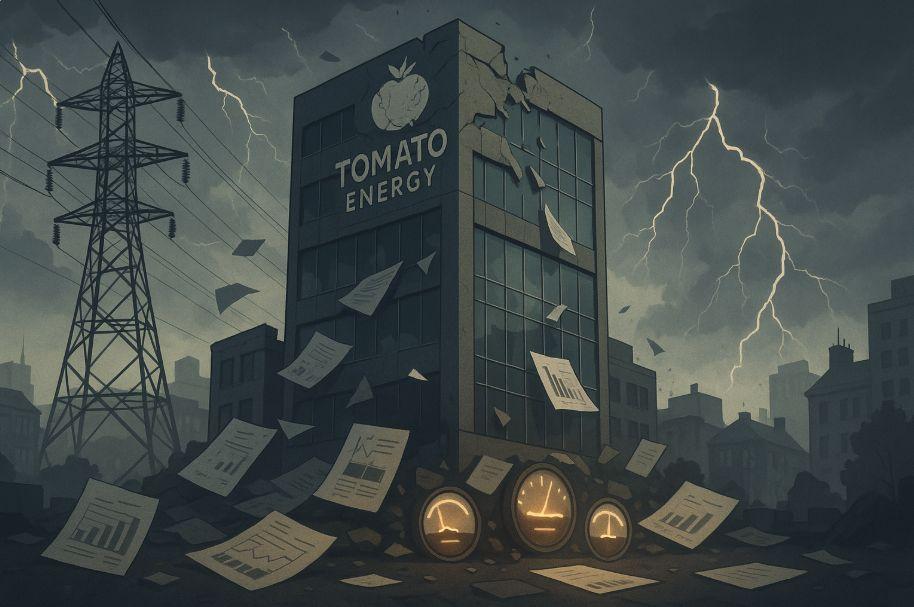In a turbulent energy market landscape, Tomato Energy, a UK-based energy supplier, abruptly ceased trading in 2025, leaving thousands of customers and industry watchers questioning what went wrong. The company had positioned itself as a competitive option in a crowded market, offering low rates and flexible terms. Yet, behind the scenes, a combination of poor financial planning, regulatory issues, and market volatility led to its downfall.
This article explores the key events that led to Tomato Energy going bust, Ofgem’s intervention, and the implications for energy customers and the UK market at large.
What Was Tomato Energy?
 Tomato Energy began as a small but ambitious energy supplier in the UK, targeting both residential and small commercial users with promises of affordable tariffs and transparent service. For a time, it managed to carve out a niche, especially among budget-conscious consumers seeking alternatives to the Big Six energy companies.
Tomato Energy began as a small but ambitious energy supplier in the UK, targeting both residential and small commercial users with promises of affordable tariffs and transparent service. For a time, it managed to carve out a niche, especially among budget-conscious consumers seeking alternatives to the Big Six energy companies.
However, the first signs of instability began to emerge in late 2024. Customers started experiencing erratic billing, difficulties contacting support, and sudden changes to their tariff plans. While these may have initially seemed like teething problems, industry insiders noticed that Tomato Energy was struggling to adapt to the rising cost of wholesale energy.
Without adequate hedging strategies in place, the company found itself paying more for energy than it was charging customers a dangerous imbalance.
Why Did Tomato Energy Go Bust in 2025?
The collapse of Tomato Energy in 2025 was the result of several interlinked factors that ultimately made its business unsustainable. At the core of the issue was the surge in wholesale energy prices, which many small suppliers failed to anticipate or manage effectively. For Tomato Energy, these rising costs quickly outpaced the fixed, low-cost tariffs they had promised to their customers.
Without the financial reserves to cover these losses, the company began defaulting on its obligations. Ofgem revealed that Tomato Energy had missed critical regulatory payments, including Renewable Obligation payments required by all UK suppliers. Additionally, the firm’s internal financial systems were unable to adapt quickly enough, causing a backlog of customer issues and mounting operational expenses.
The lack of adequate hedging a financial strategy that allows companies to fix energy costs in advance left Tomato Energy dangerously exposed to market volatility. Unlike larger suppliers with the resources to manage these fluctuations, Tomato Energy simply couldn’t absorb the rising costs.
Eventually, Ofgem had no choice but to revoke the company’s licence, citing its inability to comply with fundamental supplier obligations.
How Did Ofgem Respond to Tomato Energy’s Collapse?
As the UK’s energy regulator, Ofgem stepped in immediately to protect customers and maintain stability in the market. Under the Supplier of Last Resort (SoLR) scheme, all of Tomato Energy’s customers were transferred to another licensed energy provider without disruption to their supply.
This emergency framework is designed to ensure that no household or business is left without gas or electricity, even when a supplier fails. Ofgem also worked to protect customer credit balances and communicated regularly with affected consumers throughout the transition.
Additionally, Ofgem launched a formal investigation into the company’s conduct leading up to the collapse, particularly focusing on its missed financial obligations and whether appropriate governance was in place.
What Happened to Tomato Energy’s Customers After the Shutdown?
 Following the revocation of Tomato Energy’s licence, customers were moved to a new energy provider selected by Ofgem. This transition happened seamlessly, ensuring that there was no disruption in energy supply. However, many customers found themselves on more expensive “deemed” tariffs under their new supplier.
Following the revocation of Tomato Energy’s licence, customers were moved to a new energy provider selected by Ofgem. This transition happened seamlessly, ensuring that there was no disruption in energy supply. However, many customers found themselves on more expensive “deemed” tariffs under their new supplier.
While these deemed rates can be frustratingly higher, customers were given the freedom to switch to a different provider without facing any penalties. Ofgem also guaranteed the protection of all existing credit balances, easing concerns over lost funds during the handover.
Although the process was relatively smooth on a logistical level, some customers expressed frustration over the lack of clear communication from Tomato Energy in its final days and the sudden jump in their bills.
How Did Tomato Energy’s Business Model Contribute to Its Failure?
Tomato Energy’s downfall was also tied closely to its flawed business model. The company’s strategy focused on offering some of the cheapest energy rates in the market in a bid to quickly scale its customer base. While this approach may have attracted rapid growth, it left very little room for error in a volatile market.
By selling energy at prices that didn’t reflect the real-time cost of purchasing it, Tomato Energy was constantly operating at a loss. The absence of a robust risk management framework meant the company was unprepared for the unprecedented surges in wholesale prices in late 2024 and early 2025.
Moreover, Tomato Energy’s reliance on aggressive pricing left it vulnerable when customer acquisition slowed. Without a backup plan or enough working capital, the company couldn’t sustain operations when faced with rising expenses and unpaid regulatory dues.
Were There Any Early Signs of Tomato Energy Financial Problems?
In hindsight, several warning signs foreshadowed Tomato Energy’s collapse. Customers had been voicing concerns about erratic billing and unresponsive customer service for months before the shutdown. These complaints escalated to consumer advocacy groups and appeared on review platforms, hinting at deeper operational issues.
Internally, there were signs of instability as well. A series of senior management departures in early 2025 suggested leadership challenges. Tomato Energy also failed to submit required financial reports, raising questions about its liquidity and transparency. Ofgem flagged the company for missed Renewable Obligation payments, a critical regulatory requirement that, when unpaid, often signals financial distress.
While these indicators may not have been immediately visible to the public, they painted a troubling picture for regulators and industry observers.
What Does the Collapse of Tomato Energy Mean for the UK Energy Market?
 The fall of Tomato Energy is part of a broader trend affecting the UK energy landscape. Since 2021, over thirty suppliers have exited the market, exposing deep vulnerabilities in how new energy firms operate. The common denominator in many of these collapses is a lack of financial resilience and inadequate preparation for extreme market conditions.
The fall of Tomato Energy is part of a broader trend affecting the UK energy landscape. Since 2021, over thirty suppliers have exited the market, exposing deep vulnerabilities in how new energy firms operate. The common denominator in many of these collapses is a lack of financial resilience and inadequate preparation for extreme market conditions.
For the energy market, Tomato Energy’s demise underscores the need for more stringent supplier vetting, particularly in terms of capital adequacy and risk management practices. It also highlights the risks of over-reliance on low prices as a competitive differentiator, without the necessary support structures in place.
The situation has forced Ofgem to reassess and reinforce regulations, ensuring that future entrants into the market are more financially and operationally sound.
How Does Ofgem Prevent More Energy Suppliers from Going Bust?
In response to the wave of energy supplier failures, including Tomato Energy’s, Ofgem has implemented a more rigorous regulatory framework. New licensing conditions now require suppliers to demonstrate financial stability before entering or remaining in the market.
Ofgem also conducts ongoing assessments of operational practices and financial readiness, making it harder for underprepared companies to operate. Suppliers are now expected to have contingency plans in place and to hedge their wholesale energy purchases to protect against price fluctuations.
These preventive measures aim to shield customers from the uncertainty caused by supplier collapses, while creating a more stable and transparent energy market overall.
What Lessons Can Other Suppliers Learn from the Fall of Tomato Energy?
The collapse of Tomato Energy offers several critical lessons for other energy suppliers operating in the UK. Chief among them is the importance of building a business model that prioritises sustainability over short-term growth.
Companies need to ensure they have adequate capital reserves to weather market volatility and must comply with all regulatory requirements to avoid penalties or licence revocation. Transparent communication with customers and strong internal governance structures are equally vital.
Perhaps most importantly, suppliers must strike a balance between competitive pricing and long-term viability. The race to the bottom on pricing can be appealing in the short term, but it’s rarely a sustainable strategy in a market as dynamic as energy.
Conclusion
The downfall of Tomato Energy was not simply the story of one company’s failure. it was a reflection of systemic vulnerabilities in the UK energy market. As the country continues to navigate the complexities of energy supply and regulation, the key takeaway from this collapse is the need for greater accountability, stronger business models, and proactive oversight.
For customers, it’s a reminder to stay informed and vigilant. For suppliers, it’s a call to adopt practices that prioritise long-term health over short-term wins. And for regulators, it reaffirms the importance of ensuring that only financially sound companies are allowed to serve UK households and businesses.
FAQs About Tomato Energy Collapse
What caused the collapse of Tomato Energy?
Tomato Energy collapsed due to unsustainable pricing, poor financial planning, and missed regulatory payments.
What happens to my energy if my supplier goes bust?
Ofgem automatically assigns a new supplier to ensure your energy supply continues without interruption.
Was Tomato Energy under investigation by Ofgem?
Yes, Ofgem launched a formal investigation into the company after licence breaches were discovered.
Can I change suppliers after being moved from Tomato Energy?
Yes, customers can switch to another supplier without penalties once transferred to the new provider.
How are credit balances protected?
Ofgem ensures that customers’ credit balances are protected during the supplier switch process.
Is the UK energy market unstable?
The market has faced instability due to rising wholesale prices, but regulations have since tightened to prevent further collapses.
Are new energy suppliers being monitored more closely now?
Yes, Ofgem has introduced stronger licensing and financial checks for all new and existing energy suppliers.








